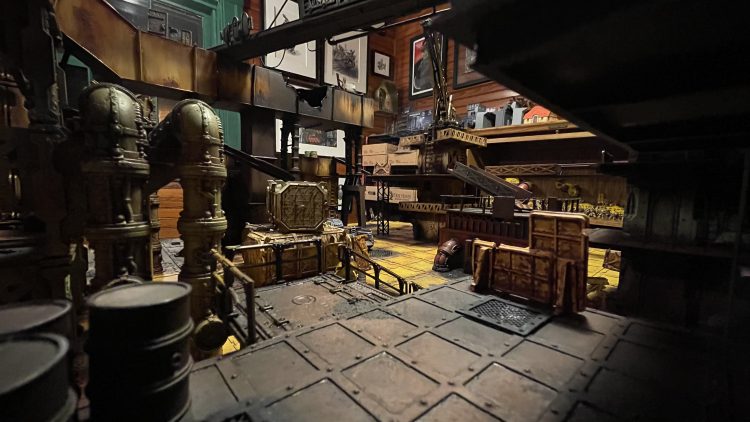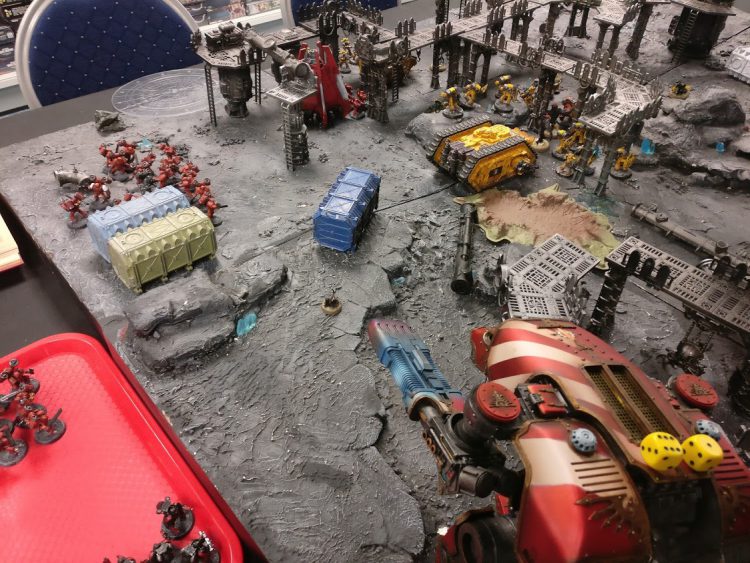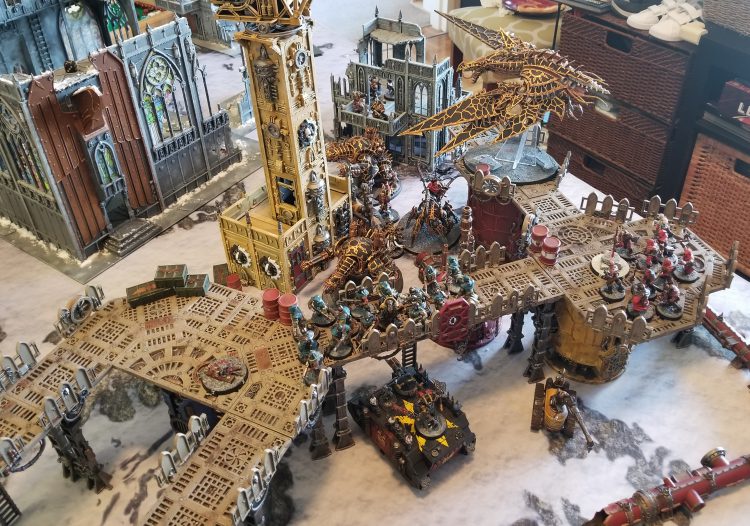In the Narrative Forge, we talk about playing games with more of a storytelling focus in mind. From bespoke missions to Crusade armies to sweeping campaigns, we cover the ways to add flavor to games. In today’s article, we’re reviewing the second phase of rules for Flashpoints: Charadon from White Dwarf 461 – how they work, and whether they’re worth your time to try out.
Another month, another set of Flashpoints. This was a special month in the sense that we also got our first taste of Flashpoints for the Mortal Realms – something RagnarokAngel will be reviewing today – and damn if they didn’t immediately make me lament what the 40k version looks like, with what looks like a meatier, more thoughtful presentation. More on that later, anyways.
This second set of Flashpoints are focused on the Charadon campaign, where Death Guard forces clash with the Adeptus Mechanicus and Imperial Knights while the Drukhari just kind of pillage around the edges. In Phase 1 we were introduced to three new Theatres of War and five Crusade Relics, which we discussed in last month’s review, which you can find here.
This month, we’ve got… four new Theatres of War and four new Crusade Relics. Let’s dig into what’s here, then we’ll offer up our thoughts on these rules and the Flashpoints project as a whole.
Theatres of War
Phase two of the Charadon campaign sees armies fighting over the Alumax System, which fell pretty quickly to Typhus’ forces through a mix of lightning raids and pestilent infiltration. The four theatres of war presented in this month’s Flashpoint represent four different planets in the Alumax System and the environments they present.

Heliotyr Penal Compound
The Prison Planet Heliotyr is a great place for the Death Guard to drum up new recruits for their shambling hordes. This Theatre of War has one ongoing game effect – you roll at the outset for how bad the Perpetual Smog will be, with the results giving varying cover bonuses, plus two random effects each battle round. Aged Defences is a random effect that each objective marker on the table can have if they reactivate during the battle (a 5+ roll for each objective at the start of each battle round). Once an objective’s defences are active, they stay active and each one can have a different effect, from turning off actions attempted on them to bonuses for holding them. You can also spend 1 CP for a special Stratagem to try and activate an objective’s defence network manually. Finally automated Searchlights randomly tag one of the six units closest to the table center at the start of each battle round, making them easier to hit and if they’re a character, allowing enemy units to ignore Look Out, Sir when targeting them.
TheChirurgeon: This battlezone has too much going on. Missions basically need at most one effect.
Beanith: Let’s play spotlight with Heavy Bolters! Searchlights is my favorite of the three just solely based on the tiny chance a character might get lit up by a spotlight before getting lit up by a wall of dakka. It’s all very Wile E. Coyote. Perpetual Smog is a bit of a snooze. Aged Defences is a very close second though, a 33% chance of an objective having one of six random effect added to it for a round doesn’t sound like much until you factor in the Active Defences Stratagem which increases your chances of finding that On switch to much more respectable 66-84% chance of success and then allowing you to choose which of the six effects you would like on a particular objective. And since the Active Defences Stratagem is used outside of the normal turn order, I do believe you can spam that sucker more than once allowing you to be that spiteful person who spends 6cp to turn all six objectives into 12” Flakk Emplacements just to kill those pesky Aircraft… or maybe not? Remind me to poke Vrekais or another adult and ask them.
Condit: There is no way I will ever remember to do all of this. I kind of like Aged Defences since the effects seem interesting and the players actually have some semblance of control over it with the Active Defences stratagem. Searchlights seems cool at first, but, if I’m honest, I have less than no desire to work out where the middle of the battlefield is or work out who the 6 closest units to it are.
Saint Bartolph’s Throne Manufactora
An industrial manufacturing district, Saint Bartolph’s is where they used to make tanks and the designers recommend the battlefield be covered industrial sectors and fuel pipes. This Theatre is unique among the ones we’ve seen so far. There’s a random effects table that assigns vehicle upgrade effects to each objective on the table at the start of the battle; these can be offensive boosts like High-Explosive Rounds that add mortal wounds on 6s to one of a vehicle’s weapons, or they can be defensive – Micro-void shield lets a player drop the damage on an unsaved incoming attack to 0 once per game.
In addition to this table, players on the Manufactora have access to three custom actions:
- Booby Traps is an INFANTRY action that a unit can perform on an objective marker to sabotage it. If an opponent comes into control of a sabotaged marker then it has a chance to take mortal wounds.
- Jury-Rigged Repairs is an INFANTRY action that lets a unit controlling an objective marker with a vehicle nearby repair the vehicle for up to D3 lost wounds.
- Hack Security Feeds is a CHARACTER action that lets you get +1 to hit an enemy unit near an objective marker.
TheChirurgeon: This is easily my favorite of the three Battlezones, in part because it’s the simplest and in part because Booby trapping objectives is something I want to see in more missions. I could do without the Equipment Stores random effects for objectives, or make that less random, but the rest is solid. Actually, this mission could have really used a custom Agenda based around gathering parts from the objective markers to score extra VP for your vehicles. That would have been a much more interesting effect.
Condit: “I like this because it’s the simplest, but it would be better if it were more complicated.” Oh-kay. In all seriousness, though, I could see myself playing a game on this as written, or at least the actions.
Beanith: Everybody, if you can, do the Bartman. Oh, yeah!
TheChirurgeon: It’s Saint Bartolph
Beanith: Well I thought was funny right up until I realised the song is over 30 years old and now I’ve made myself sad with the thought of it being considered a “golden oldie”
Easily edited out jokes aside, this will be the Flashpoint my all dreadnought crusade force will want to play all the time just using the Equipment Store table. The Actions are not bad, I’d happily have one of my Cryptek spend some time to hack the planet so I can light up a particular unit I need vaporised.
TheChirurgeon: Oh you better believe I’m leaving that garbo joke in.
Condit: Honestly, I’d quit on the spot if you didn’t.

Borthreas Salt Plains
For battles that take place in ancient dried-up seabeds, look no further than the Borthreas Salt Plains. The designers recommend these battlefield be rarely flat with few hills or tall terrain features. Seems like a recipe for a really bad game to me, though. There’s only one rule for Salt Plains, and that’s Even Footing, which lets you re-roll Advance rolls for units that don’t have a 3+ save or better and lets you ignore the penalty for firing Assault Weapons after Advancing.
TheChirurgeon: Jeez, I’m so torn. On the one hand I love the simplicity of this battlezone – only one rule to modify things and it benefits weaker units – that’s perfect. On the other hand, recommending a flat, open battlefield suuuuucks. That is literally the opposite of what you want in a game of 40k, narrative or not.
Beanith: I would recommend ignoring the Designer who probably secretly plays an Iron Hands Gun line army suggesting you play on planet bowling ball for this one.
Condit: I have read the Iron Hands supplement and there is no way anyone on the design team has ever seen an Iron Hands model in person.
Bonefields
Welcome to Da Share Zone, lads. Some of the Salt Plains are covered in bones. As you set up the table for a game on the bonefield, you alternate with your opponent placing 6 bonefield markers on the table, then roll to see what ability that bonefield has. Bonefield markers have a bunch of wacky effects; you know the drill. They’re not particularly well linked thematically, though they all have Aura abilities, which is important for the related Stratagem.
In addition to the bonefield markers, Bonefield games give you access to a custom Stratagem and an action. As an action you can destroy a bonefield marker with the Destroy the Remains action, and for 1 CP Attuned Corpses lets you pick two bonefield markers to share their auras for a turn.
Beanith: I’ve got a real bone to pick with this battlefield. Games Workshop should throw us a bone by re-releasing the Sigmarite Mausoleum as this would be the perfect battlefield to use these rules for straight out of the box… no bones about it.
TheChirurgeon: Bruh.
Beanith: Not tickling your funny bone am I? I like how they’ve included an option that, if you both agree, the six bonefield markers can all have the same effect rather than rolling separately for each one. The Action to destroy a Bonefield marker seems largely pointless. And suggesting you could just use the same Aura for all six Bonefield markers if you both agree too is an excellent idea because I’m more likely to remember one aura vs trying to remember three or four different auras scattered across the map.
Condit: I take it back. I’m quitting right now.

Crusade Relics
In addition to the rules for playing in the Theatres of War, each one has a Crusade Relic that you can equip your Characters with. If your character would gain a Battle Trait and you just won a game in an Alumax System Theatre of War, you can pick the relic that matches the Theatre you just played in to give to that character.
The Heliotyr Penal Compound has the Gambler’s Coin which will allow you once per battle round before making a hit, wound or saving roll treated as having rolled a 6.
Winning on Bartolph’s Throne Manufactora can net you the Machine-Spirit Conduit, which lets the bearer commune with a non-Titanic Vehicle model once per Command Phase, and gives you re-rolls on all of your to-hit rolls with that vehicle until your next Command phase.
For generals who find themselves winning a battle in the Borthreas Salt Planes, there’s the Sea-dragon Tooth, which gives you exploding hit rolls on unmodified 5+ results for a non-Vehicle unit.
TheChirurgeon: These relics are fucking straight fire. I’m glad the Sea-dragon Tooth is the worst of them because that Theatre sounds like a nightmare to play on, but both of these are insanely good and I really like the stakes they add to playing on these theatres of war – it makes me feel like something really good is at stake for winning, and more Crusade games need that.
Beanith: Sorry, I’ve only just come back from my happy place after imagining my Skorpekh Lord equiped with the Sea-dragon Tooth.
Final Thoughts
TheChirurgeon: They’re OK. There’s some good stuff here, some bad stuff, and a lot of mediocre stuff. They really, really need to start simplifying these rules down to something that gives us one major or at most two minor twists per mission. This could also be accomplished with like a single phase- or campaign-specific effect, with a single mission effect layered on top. Beyond the Veil does this pretty well, with Strategic Setbacks and Afflictions as your global effects that may not be used or may be altered for some missions, and an extra Investigate mechanic that you are incentivized to play with because it unlocks cool shit. That’s precisely the kind of thing these need – I’ve run multiple campaigns now and if there’s anything I’ve learned it’s that piling on a bunch of rules for a game just leads to players forgetting or ignoring the rules. Drop the random tables – your average 40k player may get in 6-12 games per year at most – and focus on the one or two things that will make a theatre of war memorable.
The relics are good though, and I like the idea of tying a solid, tangible reward to a battlezone. I’d like to see more things like that which can be part of a campaign – relics or battle traits that you can unlock after playing games on multiple theaters, for example.
Beanith: I can confirm from my games last weekend where we tried playing the Dyroch’s Reach Desert Badlands from last month’s Flashpoints layered over the Supplies from Above crusade mission. We tried dealing with floating objectives that had all shared a defensive modifier, holes in the ground and temperature jumping up and down every round before writing off 2 of the 3 extra rule tables and sticking with just one just to make things so much simpler.
That said, most of these effects are pretty awesome by themselves and I would recommend playing your Crusade missions using one or maybe two at the most at a time.
Condit: There’s a sweet spot between just playing the same mission you’d play in any other game and having so many rules that you and your opponent decide that you’d rather lie to your GM about whether you followed their plan than actually try to roll on six tables every damn round. I think Saint Bartolph’s hits that pretty well, but the other missions are either too much work or just kind of lackluster.
More troublesome to me is that this second phase is much less interesting than Argovon was at the same time – rather than introducing a new campaign mechanic to add some spice to the games and force players to make choices with no clear right answer, they’ve just added more battlezones. They’re cool, I guess, but something that gives some more flavor to the Charadon campaign would have been really cool. Maybe we’ll see that in Phase 3?
Next Time: Phase 3
Tune in next month when we review Phase 3 of the Charadon Campaign and talk about how it compares to Argovon. Until then, if you have any questions or feedback, drop us a note in the comments below or email us at contact@goonhammer.com.



